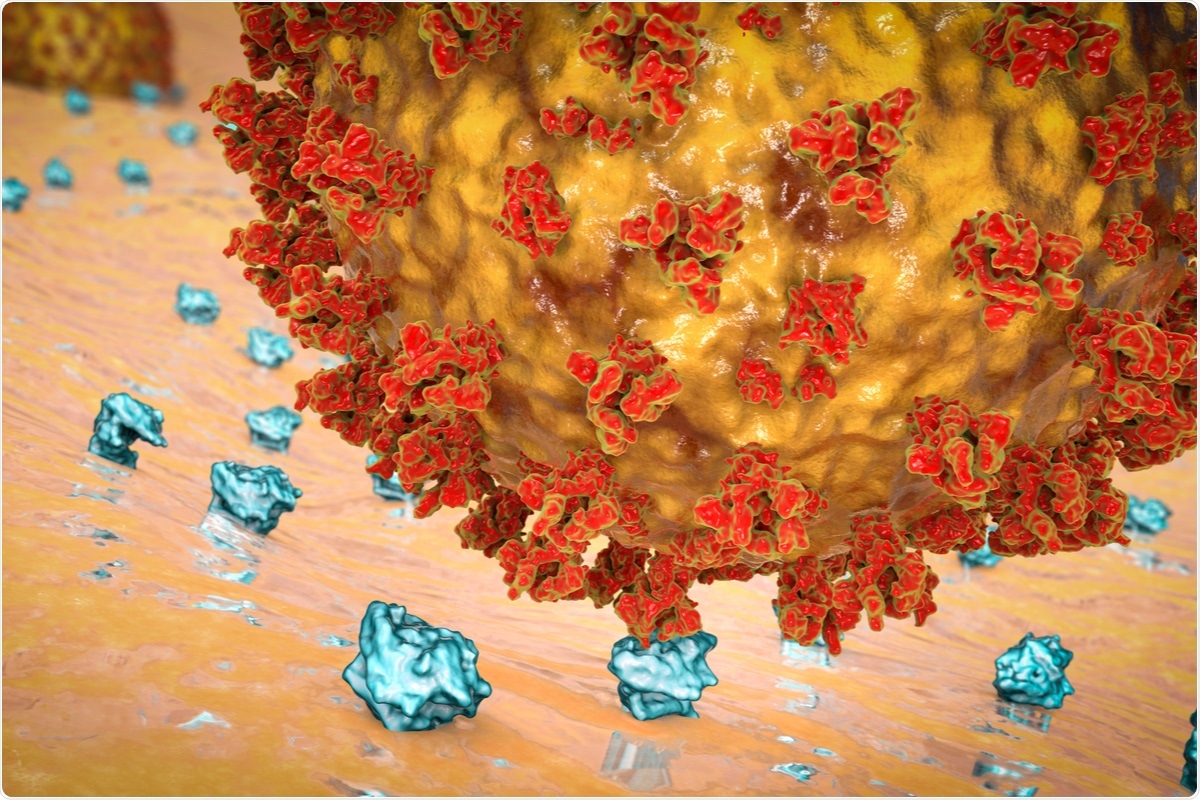As the world continues to struggle with the coronavirus disease 2019 (COVID-19) pandemic, researchers are busy searching for pharmaceuticals that can effectively counteract the pathogen. This causative agent, the severe acute respiratory syndrome coronavirus 2 (SARS-CoV-2), infects through engagement via its spike protein with the host cell, attaching to the angiotensin-converting enzyme 2 (ACE2) receptor. The spike-ACE2 interaction has thus become a prime target of antiviral strategies.

A new study appearing in the journal PLOSOne on January 8, 2021, reports the identification of several new peptides from an already existing drug bank that could be used to inhibit this binding, since they have high specificity and affinity of binding for the ACE2 receptor. The repurposing of drugs has multiple advantages. It is a cost-effective process since it deals with molecules that have already been tested for safety and efficacy within various dosages. Secondly, the manufacturing processes for commercial production of these drugs are already in place, for the most part. These are also more widely available, allowing for greater immediate access.
The ACE2 receptor is a glycoprotein localized to the membrane of several types of cells. Its N-terminal domain (NTD) and catalytic site are facing towards the extracellular space, allowing it to attach to and metabolize several peptides. The SARS-CoV-2 spike protein has an insertion loop that harbors the receptor-binding domain (RBD), in the C-terminal domain (CTD). The presence of binding residues in the RBD of the earlier SARS-CoV, in the CTD of SARS-CoV-2, and in the host receptor ACE2, indicate that these are chiefly involved in discovering and developing effective antivirals for the prevention and treatment of this condition.
The researchers first searched over a thousand compounds, using a virtual screening method to examine their ability to interact with the spike-binding surface of the ACE2 molecule. They zeroed in on two peptides likely to bind the receptor with high affinity, in conformations capable of preventing its interaction with the viral spike protein.
The scientists used molecular dynamics (MD) simulations to simulate the peptide interactions in 30 poses, each against the ACE2 binding site. MD studies are useful in evaluating the flexibility and stability of the proteins involved in binding interactions. These were refined by molecular mechanics, and the final two poses were evaluated for their docking score, and visualized, using appropriate software. Molecular docking studies have been found to be very useful in predicting potential binding ligands for a receptor, when the structure of a receptor and the ligands is known.
The protein-protein interactions (PPIs) between the spike protein and the ACE2 receptor are important in viral entry into the host cell. The researchers thus predicted and examined the PPI structures between the two molecules, with and without one of the two peptides (termed BV2) from the docking studies. Interaction energies were estimated, and MD simulations of the complex in the presence of BV2 were carried out.
These showed greater flexibility or random motions of the residues outside the interaction surface of the complex relative to those inside it. This suggests there are potential conformational changes in the complex, which remains moderately flexible. The ACE2 structure should be estimated before conducting MD studies, therefore.
Peptides that bind ACE2 at RBD-binding surface
The researchers then examined molecular docking of library molecules into the average ACE2 structure, for compounds that docked with reliable affinities or binding energies. These have the potential to bind strongly to the spike binding surface on the ACE2 receptor.
They found that in both bound and unbound states, the ACE2 receptor had comparable stability, with less than 0.01 Å. If so, the receptor's entropy may show a small reduction after the peptide drug Sar9 Met (O2)11-Substance P docks to the ACE2 receptor. This is mediated in part by hydrogen bonds linking different types of atoms in the protein-ligand complex.
There were between four and 13 hydrogen bonds observed during the MD simulation, indicating that the docked ligand is very flexible. This points to the need for cyclization or another similar strategy to reduce the entropy of such inhibitors of spike-ACE2 binding. Despite the variation in the number of hydrogen bonds, the Sar9 Met (O2)11-Substance P formed a stable complex with ACE2.
Peptide modulates spike-ACE2 PPIs
The investigators then looked at the binding free energies predicted between the spike and ACE2 receptor with and without a docked peptide inhibitor. They found that compared to -35.05 kcal/mol for the topmost pose in the absence of a peptide inhibitor, it was less than half, at -17.32 kcal/mol, in the presence of BV2, indicating that the latter restricts such PPIs.
Structural stability of PPIs
The higher the root mean square of fluctuation (RMSF) of residues in the PPI region of the ACE2-RBD complex, the more flexible (and less stable) the protein is likely to be. Conversely, the higher the root mean squared deviation (RMSD) of the backbone of the protein in the same regions, the less stable it is likely to be. In the current study, the presence of the docked peptide inhibitor caused an increase in the RMSD and RMSF.
This suggests that the docked drug disrupted the stability of the spike protein-hACE2 complex by steric and/or electrostatic interference with the interacting residues that were holding the protein-protein complex together.”
Further exploration of this aspect showed that the binding affinity between ACE2 and the viral RBD dropped by up to half when the peptide inhibitor BV2 was present. This suggests that this drug is capable of disrupting the PPI that underlies viral infection of the host cell by SARS-CoV-2.
What are the implications?
The researchers have predicted peptides that can be used as the basis to develop antivirals capable of binding the ACE2-SARS-CoV-2 spike binding surface, and inhibiting the interaction of the spike protein with its host cells. These already developed peptides require further validation and may then be repurposed for the therapy of COVID-19, as such, or in the form of newer drugs with similar structure and function.